A Pilot Randomized Crossover Study on Stress Responses in Paramedicine Students: Virtual Reality Versus Live Simulation
DOI:
https://doi.org/10.46585/hc.2024.2.2572Klíčová slova:
paramedicine, salivary cortisol, salivary testosterone, stress, virtual realityAbstrakt
Introduction: Emergency Medical Workers frequently encounter high-stress situations, such as traffic accidents
and sudden deaths, which can negatively affect their mental health. Building psychological resilience through
training is essential, and recent methods like virtual reality (VR) gamification have been introduced to improve
learning outcomes. Aim: This pilot randomized crossover study aims to compare the stress responses of thirdyear Paramedicine students during a severe traffic accident scenario using either a live actor simulation or a
VR-based platform (XVR simulation). Methods: Ten third-year Paramedicine students were randomly assigned
to start with either a live actor simulation or a virtual reality scenario using the XVR program. After completing
the first scenario, participants underwent a 7 -10 day washout period before switching to the alternate scenario.
Physiological stress markers, including salivary cortisol, testosterone, and heart rate variability (HRV), were measured before and after each scenario. Subjective stress was assessed using a ten-point visual analog scale (VAS).
Results: No significant differences were observed in cortisol concentration changes (p = 0.576), testosterone levels (p = 0.878), or HRV (p = 0.156) between the virtual reality and live actor simulations. However, students perceived the live actor scenario as more stressful than the virtual reality simulation (p = 0.001). Conclusion: Both
virtual reality and live simulations effectively recreate high-stress scenarios, but students reported higher stress
during live actor simulations. These results indicate that VR could be a viable and cost-effective alternative for
training Paramedicine students. Larger studies are needed to confirm these findings and assess the long-term
impact of VR training on stress adaptation
Stažení
Reference
Afrisham, R., Sadegh-Nejadi, S., Far, O. S., Kooti, W., Ashtary-Larky, D., Alamiri, F., Aberomand, M., Najjar-Asl, S., & Khaneh-Keshi, A. (2016). Salivary testosterone levels under psychological stress and its relationship with rumination and five personality traits in medical students. Psychiatry Investigation, 13(6), 637-643.
Andreatta, P. B., Maslowski, E., Petty, S., Shim, W., Marsh, M., Hall, T., Stern, S., & Frankel, J. (2010). Virtual reality triage training provides a viable solution for disaster-preparedness. Academic Emergency Medicine, 17(10), 871-876.
Baetzner, A. S., Wespi, R., Hill, Y., Gyllencreutz, L., Sauter, T. C., Saveman, B. I., Mohr, S., Regal, G., Wrzus, C., & Frenkel, M. O. (2022). Preparing medical first responders for crises: A systematic literature review of disaster training programs and their effectiveness. Scandinavian Journal of Trauma, Resuscitation and Emergency Medicine, 30(1), 2-23.
Cmorej, P. C., Hrach, K., Argayova, I., Peran, D., Pekara, J., Jarabicova, O., Kelbich, P., Spicka, J., & Ralbovska, D. R. (2023). Impact of personal protective equipment on the quality of chest compressions in prehospital care: A prospective randomized crossover study. Prehospital and Disaster Medicine, 38(1), 103–110.
Corrigan, S. L., Roberts, S., Warmington, S., Drain, J., & Main, L. C. (2021). Monitoring stress and allostatic load in first responders and tactical operators using heart rate variability: A systematic review. BMC Public Health, 21(1).
Darling-Hammond, L., & Snyder, J. (2015). Meaningful learning in a new paradigm for educational accountability: An introduction. Education Policy Analysis Archives, 23(7).
Dixon, M., Keane, F., & Taylor, A. (2016). Paramedic education–Is dynamic problem-based learning the way forward? Irish Journal of Paramedicine, 1(2).
Duschek, S., Bair, A., Haux, S., Garrido, A., & Janka, A. (2020). Stress in paramedics: Relationships with coping strategies and personality traits. International Journal of Emergency Services, 9(2), 203-216.
Givati, A., Street, K. I., & Markham, C. (2016). On the road again? Training paramedics in higher education in the UK [Abstract]. In ISA Forum of Sociology. Vienna, Austria.
Hayes, C. (2018). Building psychological resilience in the paramedic. Journal of Paramedic Practice, 10(4), 147-152.
Hill, Y., Kiefer, A. W., Silva, P. L., Van Yperen, N. W., Meijer, R. R., Fischer, N., et al. (2020). Antifragility in climbing: Determining optimal stress loads for athletic performance training. Frontiers in Psychology, 11, Article 10. https://doi.org/10.3389/fpsyg.2020.00272
Hill, Y., Van Yperen, N. W., & Den Hartigh, R. J. (2021). Facing repeated stressors in a motor task: Does it enhance or diminish resilience? Journal of Motor Behavior, 53(6), 717–726. https://doi.org/10.1080/00222895.2020.1852155
LeBlanc, V. R., Regehr, C., Tavares, W., Scott, A. K., MacDonald, R., & King, K. (2012). The impact of stress on paramedic performance during simulated critical events. Prehospital and Disaster Medicine, 27(4), 369-374.
Naushad, V. A., Bierens, J. J. L. M., Nishan, K. P., Firjeeth, C. P., Mohammad, O. H., Maliyakkal, A. M., ChaliHadan, S., & Schreiber, M. D. (2019). A systematic review of the impact of disaster on the mental health of medical responders. Prehospital and Disaster Medicine, 34(6), 632–643.
Zeuger, R., Annen, H., & Ehlert, U. (2023). Testosterone and cortisol responses to acute and prolonged stress during officer training school. The International Journal on the Biology of Stress, 26(1).
Stahování
Publikováno
Jak citovat
Číslo
Sekce
Licence
Copyright (c) 2024 Ondřej Kounovský, Petr Bureš, Miroslava Kuklová

Tato práce je licencována pod Mezinárodní licencí Creative Commons Attribution-NonCommercial 4.0.
Přijat 2024-12-03
Publikován 2024-12-16










